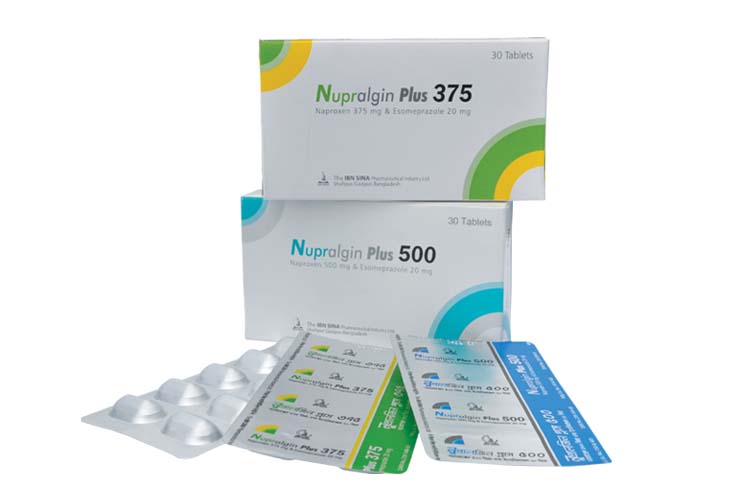
NUPRALGIN PLUS
NAPROXEN USP + ESOMEPRAZOLE BP
| NAME | STRENGTH | PACK SIZE | DOSAGE FORM |
|---|---|---|---|
| NUPRALGIN PLUS 375 MG + 20MG | 375 MG + 20MG | 30 S | TABLET |
| NUPRALGIN PLUS 500 MG + 20MG | 500 MG + 20MG | 30 S | TABLET |
Nupralgin Plus 375 Tablet: Each delayed release tablet contains Naproxen USP 375 mg and Esomeprazole Magnesium Trihydrate BP Equivalent to Esomeprazole 20 mg. Nupralgin Plus 500 Tablet: Each delayed release tablet contains Naproxen USP 500 mg and Esomeprazole Magnesium Trihydrate BP Equivalent to Esomeprazole 20 mg.
Naproxen is a NSAID with analgesic and antipyretic properties. The mechanism of action of Naproxen is like that of other NSAlDs, related to prostaglandin synthetase inhibition. Esomeprazole is a proton pump inhibitor that suppresses gastric acid secretion by specific inhibition of the H+/K+ATPase in the gastric parietal cell. By acting specifically on the proton pump, Esomeprazole blocks the final step in acid production, thus reducing gastric acidity.
Nupralgin Plus tablet is indicated for the relief of signs and symptoms of osteoarthritis, rheumatoid arthritis, ankylosing spondylitis and to decrease the risk of developing gastric ulcers in patients at risk of developing NSAlDs-associated gastric ulcers.
Carefully consider the potential benefits and risks of Nupralgin Plus and other treatment options before deciding to use Nupralgin Plus. Use the lowest effective dose of Esomeprazole lower than a total daily dose of 40 mg is more appropriate, a different treatment should be consider. Rheumatoid Arthritis, Osteoarthritis
Ankylosing Spondylitis and dysmenorrhoea; 1 Tablet twice daily. Do not split, chew, crush or dissolve the tablet. Nupralgin Plus is to be taken at least 30 minutes before meals. Hepatic Insufficiency: This combination is not recommended for use in patients with severe hepatic impairment because Esomeprazole doses should not exceed 20 mg daily in these patients.Renal Insufficiency: This combination is not recommended for use in patients with advanced renal disease (creatinine clearance < 30 ml/min).
This combination is contraindicated in patients with known hypersensitivity to Naproxen, Esomeprazole Magnesium or to any of the component. This combination is contraindicated in patients who have experienced asthma, urticaria or allergic reactions after taking aspirin or other NSAlDs. This combination is also contraindicated for the treatment of perioperative pain in the setting of coronary artery bypass graft (CABG) surgery and in patients in the late stage of pregnancy.
Use in Pregnancy: Pregnancy category C. In late pregnancy, it should be avoided because it may cause premature closure of the ductus arteriosus. Use in nursing mothers: Naproxen & Esomeprazole are likely to be excreted in human milk; a decision should be made whether to discontinue nursing or to discontinue the drug, taking into account the importance of the drug to the mother. Pediatric use: Naproxen: The safety and efficacy of Naproxen in pediatric patients below the age of 2 years have not been established. Esomeprazole: Children over 1 year are recommended to use oral Esomeprazole. Geriatric use: Caution is advised when high doses are required and some adjustment of dosage may be required in elderly patients. Hepatic Insufficiency: This combination is not recommended for use in patients with severe hepatic impairment because Esomeprazole doses should not exceed 20 mg daily in these patients. Renal Insufficiency: This combination is not recommended for use in patients with advanced renal disease (creatinine clearance < 30 ml/min).
The adverse effects reported with this combination may include gastrointestinal disorders like dyspepsia, diarrhea, nausea, flatulence, abdominal pain etc.
Pregnancy category C. In late pregnancy, it should be avoided because it may cause premature closure of the ductus arteriosus. Naproxen & Esomeprazole are likely to be excreted in human milk; a decision should be made whether to discontinue nursing or to discontinue the drug, taking into account the importance of the drug to the mother.
Several studies have shown no interaction between the two components Naproxen and Esomeprazole. NSAIDs may diminish the antihypertensive effect of ACE-inhibitors. Probenecid increases Naproxen anion plasma levels and extends its plasma half-life significantly. Co-administration of oral contraceptives, diazepam, phenytoin or quinidine does not seem to change the pharmacokinetic profile of Esomeprazole.
No specific information is available on the treatment of over dosage with Rifaximin. In case of over dosage, discontinue Rifaximin, treat symptomatically and institute supportive measures as required..
Keep in a cool (below 30°C) and dry place, protected from light. Keep out of the reach of children.
Nupralgin Plus 375 tablet: Each box contains 3x10 tablets in Alu-Alu blister pack. Nupralgin Plus 500 tablet: Each box contains 3x10 tablets in Alu-Alu blister pack.
